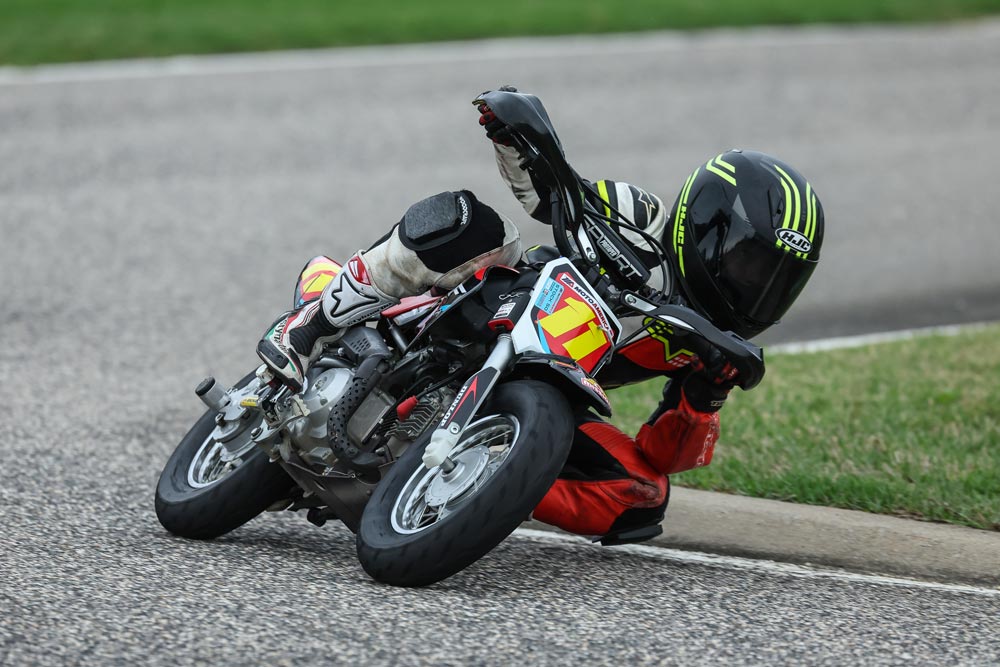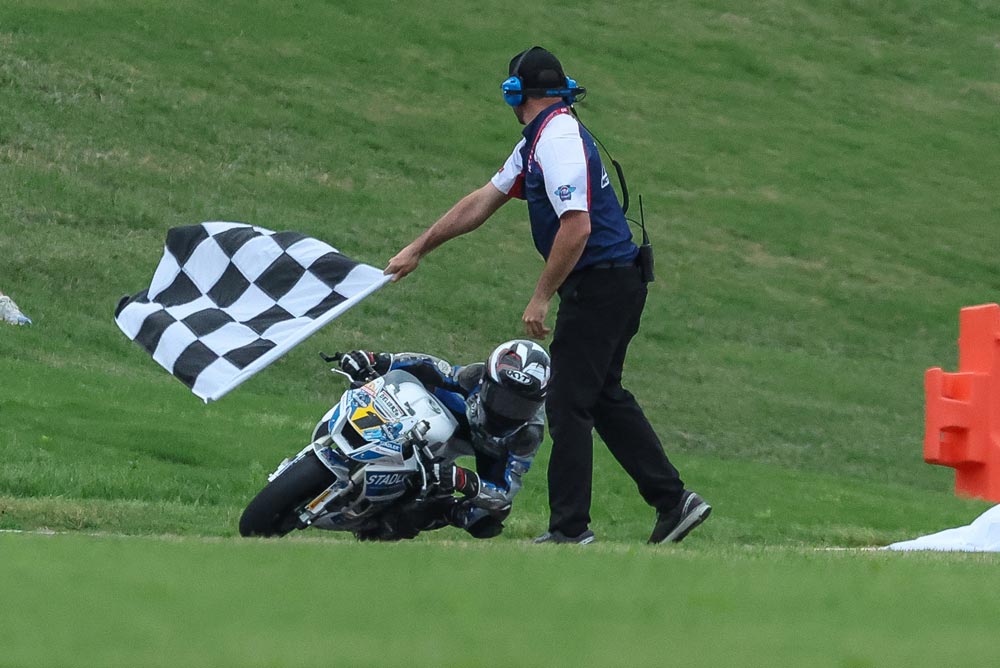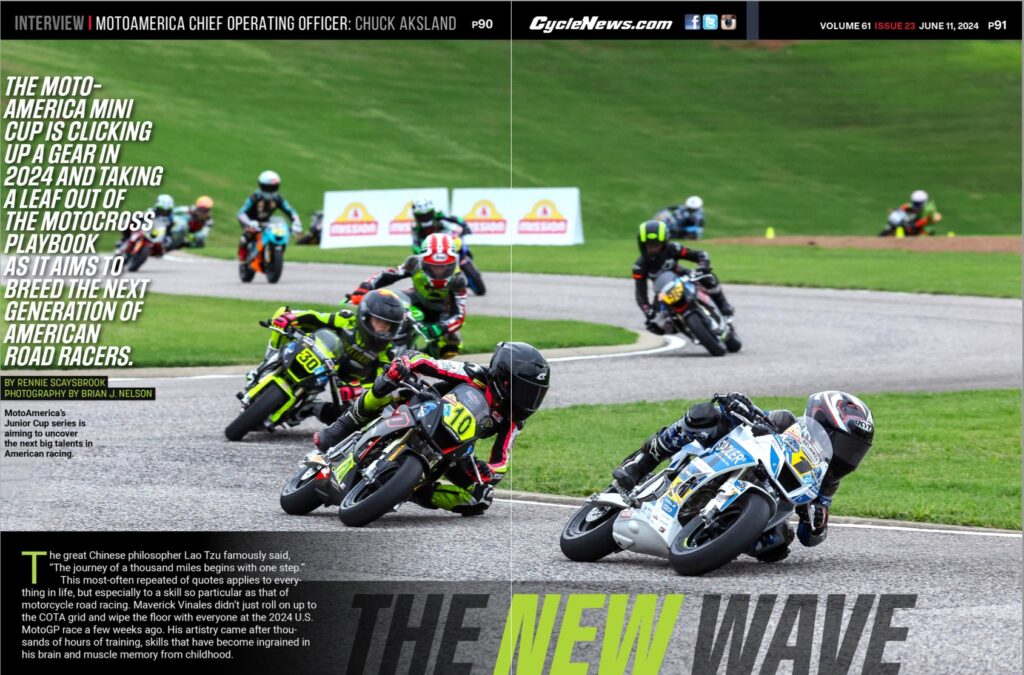Rennie Scaysbrook | June 14, 2024
The great Chinese philosopher Lao Tzu famously said, “The journey of a thousand miles begins with one step.”
This most-often repeated of quotes applies to everything in life, but especially to a skill so particular as that of motorcycle road racing. Maverick Vinales didn’t just roll on up to the COTA grid and wipe the floor with everyone at the 2024 U.S. MotoGP race a few weeks ago. His artistry came after thousands of hours of training, skills that have become ingrained in his brain and muscle memory from childhood.
But, to get there, he first had to start racing.
 MotoAmerica’s Mini Cup series is aiming to uncover the next big talents in American racing.
MotoAmerica’s Mini Cup series is aiming to uncover the next big talents in American racing.
Photography by Brian J. Nelson
Getting kids started in road racing has been a conundrum in America for far too long. While numerous clubs around the country have diligently given youngsters the chance to get on track and start the journey to perhaps professional racing stardom, those at the top of the sport in America have largely neglected the base to focus on the top of the pyramid in the AMA Superbike/MotoAmerica series.
There was a famous quote by former Australian Formula Xtreme promoter Terry O’Neill, who—when I spoke to him in 2010 regarding the possible involvement of factory teams in his series as opposed to the Motorcycling Australia-run ASBK championship—told me, “Look after the base, and the top will follow.”
In other words, O’Neill didn’t care if factory teams came or not. His grids were flush with paying privateer customers, the base of pretty much any championship outside of MotoGP, while ASBK struggled to get more than 15 superbikes on the grid. For him and a great many others involved in the FX series at the time, it was happy days. His base was strong.
The last 10 years or so have seen a massive rise in the popularity of junior road racing, pushed largely by Dorna and the incredibly competitive Spanish national junior championships. Now, MotoAmerica is properly getting behind its own national series with the help of affiliated clubs across the country to strengthen its base and ensure the next generation of American road racers is as good as it can be.
After running several events alongside select MotoAmerica rounds in 2022 and 2023 following the takeover of American junior road racing from Brandon Cretu, the MotoAmerica Mini Cup has split from a sideshow to its own show, complete with a Loretta Lynn’s-style national final to be held at Road America on August 9-11.
 Chuck Aksland is roping in various clubs across the country to help push the Mini Cup initiative.
Chuck Aksland is roping in various clubs across the country to help push the Mini Cup initiative.
“Over several years, we’ve tried to run the Mini Cup a few different ways,” says MotoAmerica COO Chuck Aksland. “We’ve tried to make a Mini Cup National Championship where you came out of the West Coast and East Coast, some involved with our racing and some that weren’t, some that were standalone.
“Then, last year, we made the MotoAmerica-sanctioned series an East Coast deal. We had our Mini Cup rounds, and we also ran the FIM Mini Cup events, which are two different things. We would run the FIM side on a Friday and then our races on Saturday, but that got logistically very complicated.”
The answer was to split the FIM Mini Cup rounds off the MotoAmerica program, handing the duties to the ASRA (American Superbike Racing Association) organization, run out of Pennsylvania. The 2024 FIM Mini Cup Championship runs for five rounds up and down the East Coast, with three of the five rounds running in conjunction with ASRA Championship rounds. The top two finishers from both the Ohvale 160 and 190 categories will then have the chance to race at the FIM MiniGP World Series Final at the season-ending 2024 Valencia MotoGP.
 Fuller grids for a shot at the national title is one of the main aims of the series.
Fuller grids for a shot at the national title is one of the main aims of the series.
With the FIM championship taken care of, attention moved to creating a series that links up racing clubs from across the country into a funnel that concludes with the one-round national championship final at Road America.
“The goal is to develop the road racing Loretta Lynn’s, if you will,” Aksland explains, nodding to the world-famous event that has become the premier talent shop for future motocross stars. Win Loretta’s, and you’re on your way.
“We have six regional clubs on board for our first go (at a state/regional series that culminates in the national final). There are 20 qualifiers across 10 different states that are going on simultaneously, kind of like the motocross programs.
“The incentive is that if you are a participant and go to your club with the intention of going to the national final, if you go do one local club race, you’ll get 10 points towards your tally for the national championship.
“At the national championship final, we’re going to run four races over two days. We’ll have a practice day and four races. You’ll have a points accumulation; the guy with the most points is the national champion. So, if you do a qualifier in a local region, just one, you’ll get 10 points to start the national with. That means you’ll have some impetus to participate in your local area.
“It’s been interesting and good for the sport. These participating clubs are now connected to MotoAmerica, and then we’ve got this agenda with this national championship going on. There seems to be quite a lot of enthusiasm for it, a lot of positive. Hopefully, over time, that national championship will really mean something.”
 The barrier to entry is greatly reduced with bikes like Honda’s CRF50 and CRF110 eligible.
The barrier to entry is greatly reduced with bikes like Honda’s CRF50 and CRF110 eligible.
Clubs that have signed up include the Southern Californian 2 Wheels Track Days, Utah Sportbike Association, Rocky Mountain Mini Moto, Northern Nevada Kart Club, Northwest Mini Moto and ASRA, whose two rounds in July and August (that also count as qualifying rounds for the FIM Mini Cup final), go towards the MotoAmerica points tally.
“We’ve got Utah, Colorado, Northern California, Washington, Oregon, and the Northeast via ASRA covered,” Aksland says, “and there’s a club already interested from Illinois. Next, we’re working on Texas.
“Every club runs a little bit different, and we’re not so worried about how they run their events, but the technical rules of the classes have to be the same as what the national final is going to be. That’s our only requirement for the clubs,” Aksland says. “The class structure has to be the same. If they combine classes within their own races because they need to for their own purposes, that’s fine this first year. We’re being pretty flexible on it and just trying to get this program introduced and get it underway.
“Another difference is when we were doing the championship previously, you had to get a license to do it, which was kind of expensive, plus pay your entry fees and all that kind of stuff. To help make it easier, now you just buy an AMA membership, sign up and go have some fun.”
 Nathan Gouker charges under the checkered flag at Barber in 2023.
Nathan Gouker charges under the checkered flag at Barber in 2023.
Part of the need for a split series is the fact that America is a massive country, far larger than road racing hubs like Great Britain and Italy, and racing is expensive enough without having to factor in cross country travel with all your bike gear.
“The travel is expensive!” Aksland says. “So, we’re thinking that if kids can participate in a local region and they want to be a national champion, a lot of families could schedule their vacation around one weekend. You’re not trying to burn six weekends.”
The series and its participants are also getting help in the form of $130,000 in contingency payouts from Yamaha, Kawasaki and Honda, proving you’re never too young to start making money in racing.
“The travel is expensive! So, we’re thinking that if kids can participate in a local region and they want to be a national champion, a lot of families could schedule their vacation around one weekend. You’re not trying to burn six weekends.”
It’s early stages yet for the MotoAmerica Mini Cup series, but there’s never been a shortage of motorcycle racing talent in this country, it’s more been a problem of where and what to race, and to have a structure that allows the bright young stars to shine and make a real go of it. And besides, motorcycle racing as a kid is about as much fun as you can have, especially when it becomes a real family affair.
“We’ve even got a Street GP class, which is essentially Honda Groms and the Kawasaki Z125 Pro. That’s for 12 years and up, but we’re hoping that maybe the dads want to come along and have some fun as well.”
A bit of family rivalry is always a good thing. But more important than that is ensuring the junior base of road racing is strong and continues to grow long into the future, producing champions who once again bear the Stars and Stripes.
Visit the MotoAmerica Mini Cup website for more information, including a breakdown of Mini Cup classes, eligibility, and contingencies.CN
VIDEO | Round One Of Mini Cup By Motul At Road America 2
